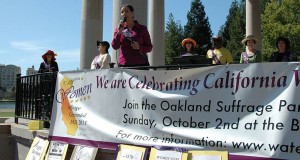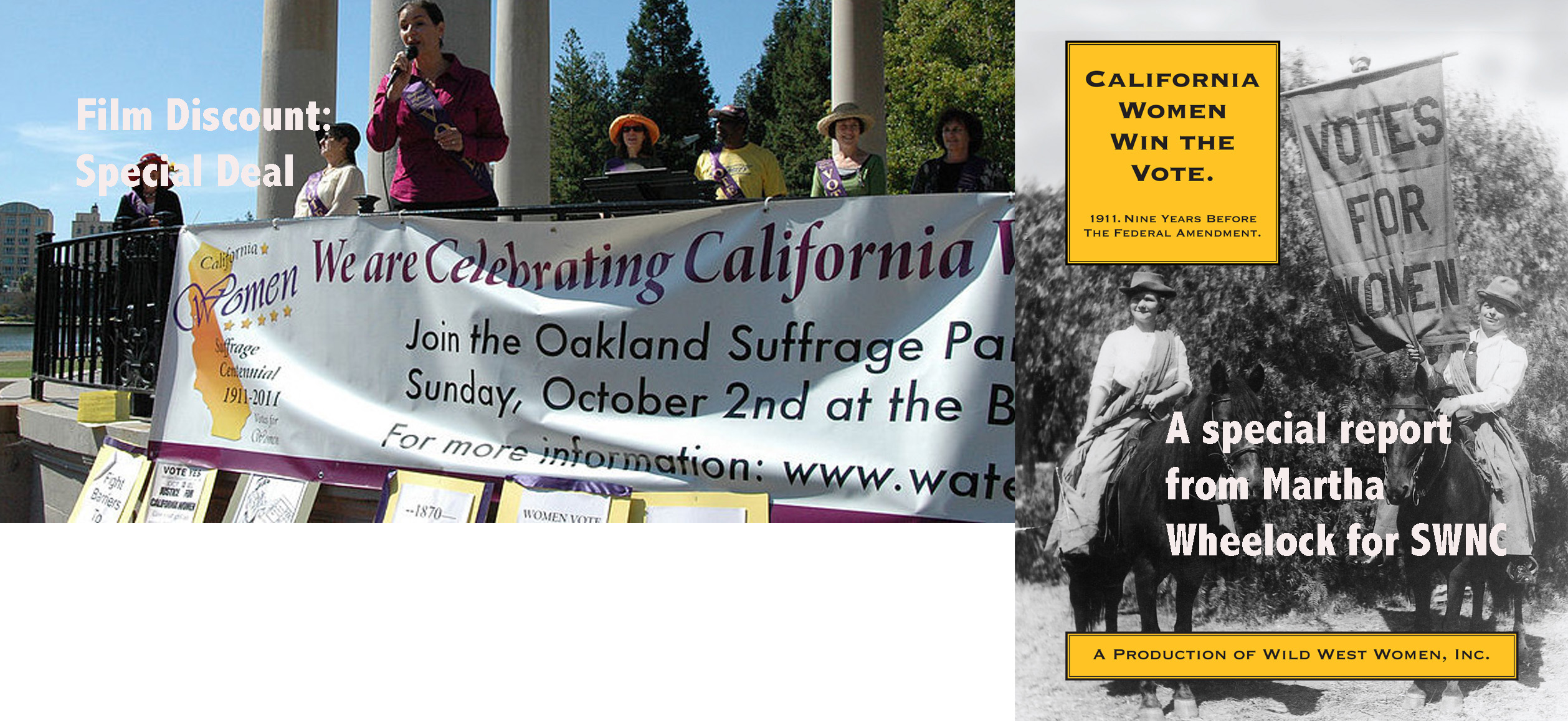
An Inspirational Story from the California Suffragists:
When we women voted for U.S. President in November 2012, we marked the 100th anniversary of California women’s first vote for president, an election when 90 per cent of the rest of American women could NOT vote. When researching the story of California suffragists’ victory for the documentary film, California Women Win the Vote, I learned how they won the vote, and why this early suffrage victory made a difference in women’s lives. So, women voters, take heed of the lessons they showed us.
As we learn some much-needed women’s history, we know that women were not given the right to vote by founding fathers or by beneficent statesmen. Women had to WIN their right to vote in hard-fought campaigns over a 72 year period, beginning in 1848 at Seneca Falls, NY, when Elizabeth Cady Stanton pronounced that women have the right to vote! And Iron-Jawed Angels (from HBO- a must see!) demonstrates what suffragist Alice Paul and the White House pickets underwent to attract support for our suffrage cause –through hunger strikes.
CALIFORNIA’S 1911 VICTORY WAS AN INSPIRATION FOR THE REST OF THE NATION
The story of California’s suffrage campaign is less known as an early victory and as the inspiration for the rest of the country. When California women lost their first suffrage referendum in 1896 by 20,000 votes, they were not defeated, but resolute and probably darn mad. They energized the California legislature to place a suffrage amendment on the 1911 ballot. This action meant that the male voters of California would determine whether their mothers, wives, daughters, and sisters should have the right to vote. Think of the challenge that the women faced: to persuade men, who wanted their women at home, caring for their needs and families that women were suitability and importance to the society as voting citizens. An added challenge was that most women did not even know themselves why they should have the right to vote.
How to achieve this feat, in a large state in a short time? Cars were rare, railroads, limited, and radio, non-existent. The women had to be ingenious and resourceful. Because the main outlets for their cause were the 700 newspapers, women became journalists. This penetration and power of the press allowed women to spread their sensible suffrage arguments and publicize every suffrage event.
Secondly, women had to convince their men that citizenship for women was good for them too. The “new automobile invention” attracted men like a circus barker. The suffragists drove an alluring seven-seater Overland Blue Liner into towns, and as men gathered, a suffragist addressed them. Imagine, dignified women, who had never spoken in public, in long white dresses and big hats, standing on back seats of roofless automobiles, facing rowdy crowds of men to demand their right to vote! Women also spoke to crowds from turned- over wooden soapboxes. These activities happened all over the huge state – in mining towns, in orange groves, in houses of prostitution, in bars and fishing camps. Steadfastly day by day for over seven months, until every corner of the state, almost every man had been visited by suffragists.
THE SUFFRAGISTS MADE IT CLEAR: THEY WOULD NEVER GIVE UP!
Suffragists spread their demand for a “Yes” on suffrage by theatrical and spectacular events. In Los Angeles, women in a hot–air balloon tossed leaflets over the parks. They invaded baseball games to hand out voting cards. And during the races at the Ferndale Fair, women rode out between the heats on horseback, carrying banners with the omnipresent slogan, VOTES FOR WOMEN. Women in the country walked or rode horses into fields and packing plants to present their case, or they would hold plays and concerts, during which they would expose the suffrage issue.
Suffragists themselves used consumerism and commercial enterprise to spread their message for equal rights in creative, innovative and ingenious ways. For a personal identification with their cause, they distributed over 150,000 buttons and 18,000 pennants, signs and posters for citizens to wear or display—always keeping the message of Votes for Women before the public eye. Tea parties and luncheons were held to discuss suffrage, raise money, and to sell suffrage tea. In one week young women on street corners sold over 33,000 colorful and humorous postcards for five cents each to raise funds and to spread the word. Suffrage dogs were dressed in banners when they went out to the park!
Suffrage messages on such common household items as playing cards, cookbooks, flyswatters, calendars, and pot holders saturated homes Common products often stimulated discussion of the issue; the public became the voice for women’s right to vote! In this innovative, commercialized political sphere, suffragists became artists, entrepreneurs, and advertisers for their cause. Many of these tactics continue today, i.e., potholders and calendars from politicians seeking our vote.
The anti-suffrage forces, centered in San Francisco, were controlled by liquor and railroad interests that invested deeply to keep woman in her place. Women might vote for prohibition, take jobs away from men, or speak out against railroad labor practices. On Election Day, October 10, 1911, San Francisco, Alameda and surrounding counties, defeated the suffrage amendment by two to one, and for the whole of that day, suffrage went down to defeat.
“EVERY COURAGEOUS MAN’S VOTE COUNTED!”
When the rural counties and Los Angeles and San Diego reported their voting tallies, two days later, suffrage had narrowly won by a mere 3,500 Votes, only 1% of the voters, one of the closest victories in political history. Indeed every courageous man’s vote counted! Rural counties and southern cities recognized the enormous contributions women had made to their lives and their society. Suffrage wins because women (and some supportive men) educated the male voters and united diverse groups under one cause. All issues for rich or poor, whether labor, education, health, social reform, charity work would be handled best when women could vote.
Upon receiving their citizenship, California’s women served on juries, ran for public office, and voted for President in 1912. This suffrage victory became the inspiration and the leadership for the rest of the states, and many of our California suffragists worked for the Federal Amendment.
What can we learn from this California suffrage campaign? First, the women were civil and engaged in educating the voter. Secondly, anyone can be involved as a citizen and advocate. The work for suffrage transformed the consciousness of California women and gave them their first informal education that change is possible.
This campaign was not run by those who had experience in such work, but by women, though untrained, whose fervor was tireless, by women who had no idea they could ever speak in public or talk to a stranger, but who did so because they were moved to. We can make a difference when we are impassioned by the rightness of the cause. And finally, register and Vote.
Your right to vote was won, earned by hard work and dedication by our foremothers. Honor them with your involvement. It is tragic that only 64 percent of eligible Americans vote; but it is heartening that women take this privilege more seriously and in 2008, 66 percent of women voted to 61.5 percent of men.
Let us remember our women’s history, and ALWAYS VOTE!
Martha Wheelock has been a documentary filmmaker since 1978, as well as a teacher of American literature, ethics and women’s studies in high school and college. She loves women’s history and has produced three other films to celebrate our history and other films to acknowledge women writers and artists.
FOR MORE INFORMATION:
You can see a trailer for the film CALIFORNIA WOMEN WIN THE VOTE at www.ishtarfilms.com or www.wildwestwomen.org or https://www.facebook.com/photo.php?v=389806221035224
If you write Martha Wheelock directly: mwheelock@sbcglobal.net. She will take 25 percent off the DVD with free shipping. Total price is $19.95. Available on the website: www.wildwestwomen.org Also see this link.
